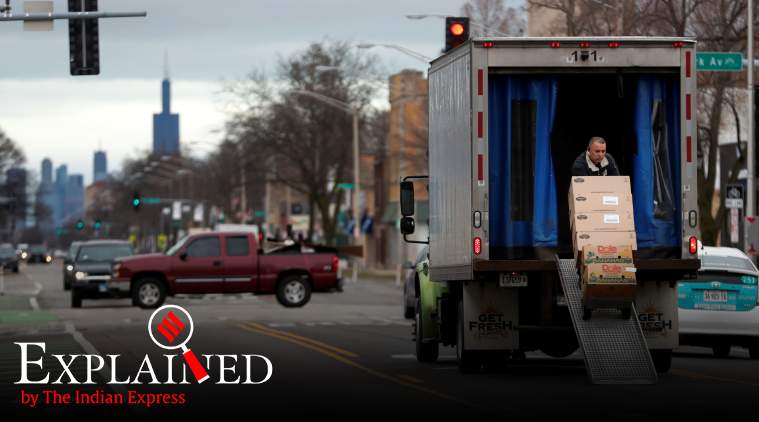Coronavirus: The strategy of ‘shelter in place’ adopted by several American states
Shelter in place orders: It conveys the broad idea of a set of restrictions being put into place, but follows not set definition.
 A delivery man unloads his truck on what is usually a busy Madison Ave. in the Village of Oak Park, Ill., Friday, March 20, 2020. Chicago’s mayor has ordered residents to shelter in place. (AP Photo: Charles Rex Arbogast)
A delivery man unloads his truck on what is usually a busy Madison Ave. in the Village of Oak Park, Ill., Friday, March 20, 2020. Chicago’s mayor has ordered residents to shelter in place. (AP Photo: Charles Rex Arbogast)
As Indians observe a “janata curfew” from 7 am to 9 pm on Sunday (March 22), refraining from making any non-essential movements, they are implementing a version of what is referred to, most commonly in the United States, as a “shelter in place” order.
Governors in several American states have issued executive orders aimed at slowing the spread of the virus, asking people to stay at home as much as possible, and enacting rules to limit the sizes of gatherings, and putting curbs on older Americans with underlying illnesses.
By Sunday, at least a fifth of the US population was under orders to stay home, and this percentage was expected to increase.
What exactly is a “shelter in place”, then?
In the context of the US, it is not a precise legal term, and its meaning and implications vary. It conveys the broad idea of a set of restrictions being put into place, but follows not set definition.
“Ultimately, the intent of the protocols is to ‘decide what people should and shouldn’t do based on a particular threat to the public’,” Vox quoted Wendy Mariner, the Edward R Utley professor of health law at Boston University School of Public Health, as saying in an explainer on ‘shelter in place’.
Even in India, there is no exact definition of a “janata curfew” — the Prime Minister has laid down guidelines for what Indians should not do, and authorities have taken steps to ensure compliance through appeals, advisories, and executive action such as invoking prohibitory orders. In the cities, traders’ associations and housing societies have voluntarily put curbs on themselves in response to the PM’s call.
An Expert Explains: Why airports make you ill and what to do about it
But broadly speaking, what could such an order be expected to imply?
Broadly, “shelter in place” orders everywhere, including in India, aim to achieve the overarching goal of the global battle against the COVID-19 pandemic — social distancing, which is the key to “flattening the curve”, that is, spreading out the incidence of infection over a longer time so that healthcare systems are not overwhelmed.
Everything else — including India’s janata curfew — follows from this understanding.
📢 Express Explained is now on Telegram. Click here to join our channel (@ieexplained) and stay updated with the latest
The shelter in place order issued by the health officer of the city and county of San Francisco on March 16, therefore, said the intent of the order was to urge “maximum people” to self-isolate in their places of residence, while enabling essential services to continue.
It also stated that while sharing outdoor spaces, individuals should try to maintain a distance of at least six feet from all other persons.
Here’s a quick coronavirus guide for you to stay updated: Who all should be tested for Covid-19 and when? | How should you quarantine yourself? | How often (and how) should you clean your home? | What is the Janata Curfew announced by PM Modi? | Who are restricted from coming to India, and from when? | How long can the virus live on surfaces or in air around you? | Still more Coronavirus Q&A Explained news here
- 01
- 02
- 03
- 04
- 05






































